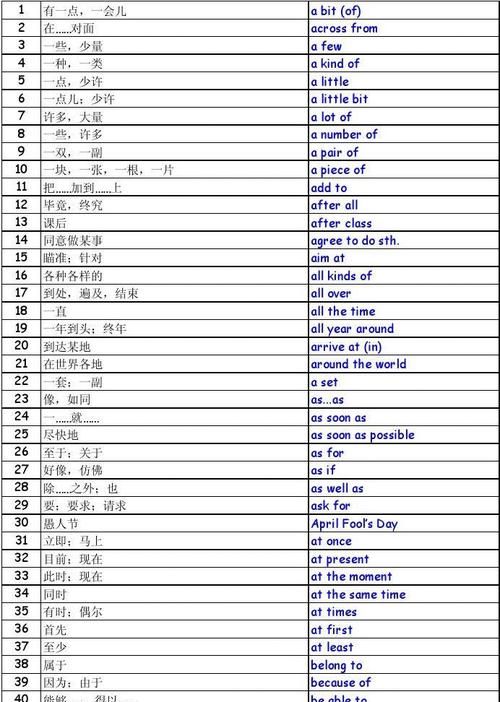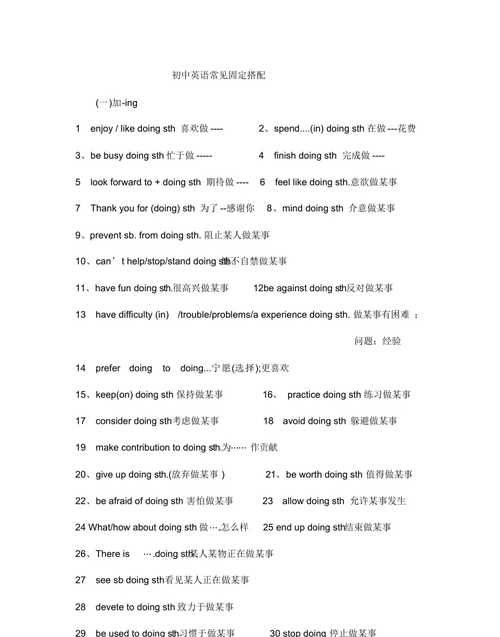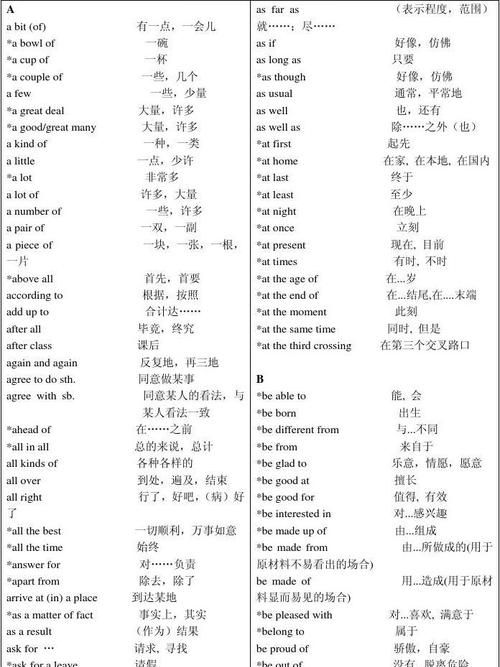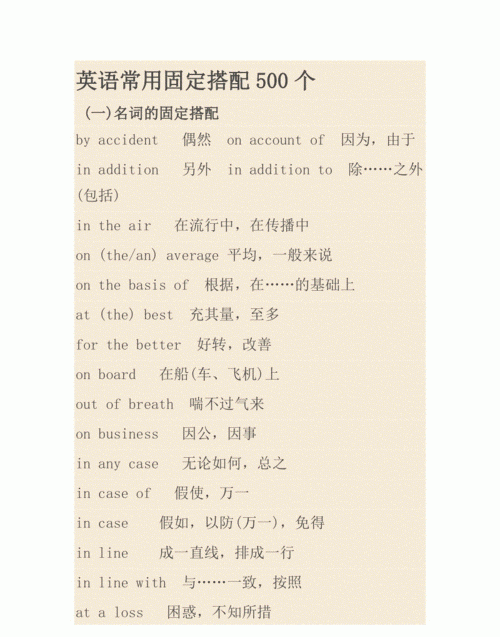本文目录
初中英语固定搭配短语大全人教版
want sb to do sth 想做
make sb do sth 让某人做
mind doing sth 考虑做
finish to do sth 完成某事(强调过去已完成)
finish doing sth 完成某事
like to do sth 喜欢某事(强调某时刻想做什么)
like doing sth 喜欢某事(强调经常做)
listen to sth 听什么
hear sb to do sth 听到某人
forget to do sth 忘记过去做过什么事
forget doing sth 忘记去做什么
how to do sth 怎么做
used to do sth 过去常常做某事
wait sb to do sth 等某人去做
hope to do sth 希望做什么
sb want to do sth 某人想做什么
be busy doing sth 忙于做什么
do one‘s best to do sth 某人最好做什么
sb need to do sth 需要某人做某事
try to do sth 尝试去做
tell sb to do sth 告诉某人做某事
tell sb not to do sth 告诉某人不要做某事
stop sb from doing sth 阻止某人做某事
have trouble doing sth 做某事有困难
go on doing sth 继续做某事(强调正在做)
be interested in doing sth 对做某事有兴趣
be afraid to do sth害怕做某事
too...to do sth 太,,,而不能做
end up doing sth 结束某事
get used to do sth 过去常常做某事
What about doing sth 做某事怎么样
mind one‘s doing sth 介意某人做某事
ask sb about doing sth 询问某人做某事怎么样
love to do sth 喜欢做某事(表示过去常常做)
love doing sth (表示现在想做什么)
it is time to do sth 是做某事的时间了
enjoy doing sth 专注于,喜欢做某事
do well in doing sth 某事做得好
the best way to do sth 做某事最好的方法
you‘d better to do sth 你最好做某事
watch sb to do sth 看某人做某事
decide to do sth 决定做某事
give up doing sth 停止做
agree to do sth 同意做某事
see sb doing sth 看到某人做某事
allowed sb to do sth同意某人做某事
remember to do sth 记得以前做过某事
remember not to do sth 记住不要去做某事
remember doing sth 记住要做某事
consider doing sth 考虑去做某事
pretend to do sth 假装做某事
prefer to do sth 宁愿做某事
can‘t stand doing sth 不能忍受做某事
楼主,我找到这些词组,中文都是我一手打上的,
希望多加分,实为不易啊~~~

初中英语固定搭配短语大全
139. be (get ) ready 准备好 140. be ready for sth.(get ready to do sth./prepare for) 准备…
141. be shocked at 对……感到震惊,对……感到惊讶 142. be shown 被陈列
143. be short for 是……的简称 144. be sorry for 感到抱歉
145. be sure 肯定;确信 146. be sure of 深信;确信
147. be sure that 确信 148. be sure to do sth. 一定要;务必
149. be surprised at 使……感到意外吃惊 150. be surprised by 使……吃惊,使……感到意外
151. be tired from 因……疲倦 152. be tired of 对……厌倦
153. be to 将要做 154. be up (时间等)到了,结束了
155. be used as +工具/手段 (被)作为….来用 156. be used by +人 (被)……用
157. be used for (被)用来做…. 158. be used to doing 习惯于
159. be used to sth. (被)用来…… 160. be worried about 担心
161. be worth doing sth. 值得做…. 162. beg your pardon 请再说(做)

初中英语常见固定搭配短语大全
一. 词汇
⑴ 单词
1. 介词:in, on, under, behind, near, at, of
1). in表示"在……中", "在……内"。例如:
in our class 在我们班上
in my bag 在我的书包里
in the desk 在桌子里
in the classroom 在教室里
2). on 表示"在……上"。例如:
on the wall 在墙上
on the desk 在桌子上
on the blackboard 在黑板上
3). under表示"在……下"。例如:
under the tree 在树下
under the chair 在椅子下
under the bed 在床下
4). behind表示"在……后面"。例如:
behind the door 在门后
behind the tree 在树后
5). near表示"在……附近"。例如:
near the teacher's desk 在讲桌附近
near the bed 在床附近
6). at表示"在……处"。例如:
at school 在学校
at home 在家
at the door 在门口
7). of 表示"……的"。例如:
a picture of our classroom 我们教室的一幅画
a map of China 一张中国地图
2. 冠词 a / an / the:
冠词一般位于所限定的名词前,用来署名名词所指的人或事物。冠词有不定冠词和定冠词两种。不定冠词有两个形式,即a和an。a用在以辅音音素开头的词前,如a book; an用在以元音音素开头的字母前,如an apple.
a或an与可数名词单数连用,泛指某类人或某物中的一个。
This is a cat.
这是一只猫。
It's an English book.
这是一本英语书。
His father is a worker.
他的爸爸是个工人。
the既可以用在可数名词前,也可以用在不可数名词前,表示某个或某些特定的人或事物,也可以指上文提到过的人或事物。
Who's the boy in the hat?
戴帽子的男孩是谁呀?
------ What can you see in the classroom?
------ I can see a bag.
------ Where's the bag?
------ It's on the desk.
------- 你能在教室里看到什么呀?
------ 我能看见一个书包。
------ 书包在哪呀?
------ 在桌子上。
3.some和any
①在肯定句中用some.例如:
There are some books on the desk.桌子上有一些书。
Lucy has some good books露西有一些好书。
②在疑问句和否定句中用any。例如:
Is there any ink in your pen?你的钢笔里有墨水吗?
Do you have any brothers and sisters?你有兄弟姐妹吗?
There isn't any water in the glass.杯子里没有水。
⑵记住它们的特殊用法。
①some亦可用于表示盼望得到对方肯定的答复或表示建议、委婉请求的疑问句中,这一点我们不久就会学到。例如:
Would you like to have some apples?你想吃苹果吗?
②any也可用于肯定句中,表示"任何的"。例如:
Any one of us can do this.我们当中任何一个都能做这个。
some 和any的用法是经常出现的考点,希望大家能准确地掌握它们的用法。
4.family
family看作为一个整体时,意思是"家庭",后面的谓语动词be用单数形式 is ;如把family看作为家庭成员时,应理解为复数,后面的谓语动词be应用are。
My family is a big family. 我的家庭是个大家庭。
My family are all at home now. 我的家人现在都在家。
Family强调由家人组成的一个集体或强调这个集体中的成员。home指个人出生、被抚养长大的环境和居住地点。 house指"家"、"房屋",侧重居住的建筑本身。
His family are all workers. 他的家人都是工人。
My home is in Beijing. 我的家在北京。
He isn't at home now. 他现在不在家。
It's a picture of my family. 这是一张我全家的照片。
5. little的用法
a little dog 一只小狗,a little boy 一个小男孩。little常用来修饰有生命的名词。
*但little还可表示否定意义,意为"少的",加不可数名词。
There is little time. 几乎没时间了。
There is little water in the cup. 杯中水很少。
⑵ 词组
on the desk 在桌子上
behind the chair 在椅子后
under the chair 在椅子下面
in her pencil-box 在她的铅笔盒中
near the door 在门附近
a picture of a classroom 一个教室的图片
look at the picture 看这张图片
the teacher's desk 讲桌
a map of China 一张中国地图
family tree 家谱
have a seat 坐下,就坐
this way 这边走
二. 日常用语
1. Come and meet my family.
2. Go and see. I think it's Li Lei.
3. Glad to meet you.
4. What can you see in the picture?
I can see a clock / some books.
5. Can you see an orange?
Yes, I can. / No, I can't.
6. Where's Shenzhen?
It's near Hong Kong.
7. Let me see.(口语)让我想想看。
see 在这是"明白、懂了",不可译作"看见"。例如:
8. Please have a seat.
seat表示"座位",是个名词。have a seat表示"就坐",也可以说take a seat, 和sit down的意思相同。
三. 语法
1. 名词所有格
名词如要表示与后面名词的所有关系,通常用名词所有格的形式,意为"……的"。一般有以下几种形式:
(1). 一般情况下在词尾加"'s"。例如:
Kate's father Kate的爸爸
my mother's friend 我妈妈的朋友
(2). 如果复数名词以s结尾,只加"'"。例如:
Teachers' Day 教师节
The boys' game 男孩们的游戏
(3). 如果复数名词不以s结尾,仍加"'s"。例如:
Children's Day 儿童节
Women's Day 妇女节
(4). 表示两个或几个共有时,所有格应加在后一个名词上。例如:
Lucy and Lily's room Lucy 和Lily的房间
Kate and Jim's father Kate 和Jim的爸爸
动物和无生命事物的名词的所有格一般不在词尾加"'s",而常常用介词of的短语来表示。
a map of China 一幅中国地图
the name of her cat 她的猫的名字
a picture of my family 我的家庭的一张照片
the door of the bedroom 卧室的门
2. 祈使句
祈使句主要用来表示说话人的请求、命令、建议、叮嘱等意图。祈使句一般不用主语,读时用降调。为使语气委婉、礼貌,常在句首或句尾加please 。在句尾时,please前多用逗号。
(1). 祈使句肯定形式的谓语动词一律用动词原形。
Go and see. 去看看。
Come in, please. 请进。
(2). 祈使句的否定形式常用don't于句首。
Don't look at your books. 不要看书。
Don't play on the road. 不要在马路上玩。
3. There be 的句子结构
There be是一个"存在"句型,表示"有"的意思,
肯定句的形式为:There be + 名词(单数或复数)+地点状语或时间状语。
be动词单复数的确定,看be后边第一个名词,当所接主语为单数或不可数名词时,be动词形式为is;当所接主语为复数名词时,be动词为are;当be动词后接两个以上主语时,be动词与最临近主语保持数上的一致。意思为"某地有某人或某物"。如:
There is an eraser and two pens on the desk. 桌子上有一块橡皮和两支钢笔。
There are two pens and an eraser on the desk. 桌上有两支钢笔和一块橡皮。
(1)there be的否定句,即在be的后面加上not。
否定形式为:There be + not + (any) + 名词+地点状语。
There is not any cat in the room. 房间里没猫。
There aren't any books on the desk. 桌子上没书。
(2)there be句型的疑问句就是将be提到句首:Be there + (any) +名词+地点状语?肯定回答:Yes, there is / are. 否定回答:No, there isn't / aren't.
---Is there a dog in the picture? 画上有一只狗吗?
---Yes, there is. 有。
---Are there any boats in the river? 河里有船吗?
---No, there aren't. 没有。
(3)特殊疑问句:How many . . . are there (+地点状语)?"某地有多少人或物?"回答用There be . . .
There's one. / There are two / three / some . . .
有时直接就用数字来回答。One. / Two . . .
---How many students are there in the classroom? 教室里有多少学生?
---There's only one. / There are nine. 只有一个。/有九个。
(4)如果名词是不可数名词,用:How much + 不可数名词 + is there + 地点状语?
How much water is there in the cup? 杯中有多少水?
How much food is there in the bowl? 碗里有多少食物?
001. a bottle/glass/cup… of 一瓶/茶杯/玻璃杯
002. a few 一些
003. a kind of 一种;一类
004. a little 一点;少量
005. a lot of…(lots of…) 许多的
006. a moment later 片刻之后
007. a number of 若干的;许多的
008. a pair of 一双;一副
009. a piece of 一块(张;片;只)
010. all day(long) 整天;一天到晚
011. all kinds of 各种各样
012. all one’s life 一生;终生
013. all over 到处;结束
014. all over the world 全世界
015. all right 行了;好吧;(病)好了
016. all the same 仍然
017. all the time ①一直;始终②老是(美国英语)
018. arrive at/in 到达某地
019. as…as… 一样
020. as…as one can(=as…as possible) 尽量
021. as soon as 一就
022. at breakfast 早餐时
023. at first 起先;开始的时候
024. at home 在家
025. at last 最后;终于
026. at night 在夜里
027. at noon 在正午
028. at once 立刻;马上
029. at school 在学校上课
030. at the back of 在……的后面
031. at the head of 在……的前面
032. at the moment 此刻
033. at the same time 同时
034. at this time of (the) year 在(一年中)这个时节里
035. at times 时常;有时
036. at work 在工作
037. be able to do sth. (= can+V.) 能够
038. be angry with sb. 生某人的起 be angry at/about sth. 生某事的气
039. be born 出生
040. be different from… 和……不同
041. be full of 充满着……
042. be good at 善于 be bad at拙于
043. be good for 对……有益的 be bad for 对……有害的
044. be in hospital 生病;住院 be in the hospital 在医院
045. be late for 迟到
046. be like 像
047. be made of (be made from) ……制的;用…….制成的
048. be/get ready 准备好
049. be sure 肯定;确定
050. break down ①(机械)损坏②拆散(某物)
051. by+交通工具 搭乘某交通工具
052. by the way 顺便一提
053. by then 到那时
054. catch (a) cold; have a cold 感冒
055. change one’s mind 改变想法(注意)
056. come back 回来
057. come down 下来
058. come from ①出生于②来自于
059. come in 进入;进来come out 出来
060. come over 过来;顺便来访
061. come around (走)过来(绕行而来)
062. day after day 日复一日地;天天
063. do(es) +V.ing 做某事
064. do sport 运动;参加(体育)运动
065. does well ①做得很好②成功③成绩很好
066. each other 互相
067. eat up 吃完
068. either…or… 不是……就是
069. enjoy oneself 过得愉快
070. fall behind 落后;跟不上
071. fall off ①跌落;掉下②(质或量)下降
072. far away 遥远
073. feel like doing sth. 想要做某事
074. feel tired 感到疲劳
075. find out 查明;发现;了解
076. from now on 从今以后;今后
077. from … to … 从……到……
078. get back ①返回②取回
079. get down ①下来;落下②记下来
080. get dressed 穿衣服
081. get home 大家
082. get into ①进入②搭乘(出租车)③陷入(坏的情况)
083. get off ①下车②起飞
084. get on ①上车②生活
085. get on (with…)= get along (with…) ①生活②与(某人)相处③(活动)有进展
086. get out of ①从......出来②从出租车(轿车)下来
087. get ready to do sth. 准备做某事
088. get up ①起床②起立
089. get warm (long) 变暖和(长)
090. give a call 给……打电话
091. give back 归还;送回
092. go back 回去
093. go for a walk 散步
094. go home 回家
095. go on 继续
096. go shopping 去购物
097. go to bed 睡觉(并未入睡)
098. go to school 上学
099. go to sleep 入睡;睡着
100. go to the cinema 看电影
101. grow up 成年;长大成人
102. half an hour 半小时
103. have a drink of 喝一点……
104. have good time 玩得很高兴;过得愉快
105. have a look (at) 看一看
106. have a match 比赛have a test 测验
107. have a meeting 开会
108. have a rest 休息
109. have a swim 游泳
110. have a talk 谈话
111. have a walk 散步
112. have a wash 洗(手,脸等)
113. have breakfast 吃早饭
114. have lessons/classes 上课
115. have lunch 吃午饭
116. have sport 进行体育活动
117. have supper 吃晚饭
118. have to 不得不;必须
119. hear from+sb. 收到某人的来信
120. hear of 听说
121. help sb. with sth 在某事上帮某人help sb. (to) do sth. 帮助某人做某事
122. hold a meeting (= have a meeting) 举行会议
123. hold on ①等一等(别挂电话)②坚持;持续
124. hour after hour 一小时又一小时地;持续地
125. how long ①(时间)多长;多长②(长度)多长
126. how many/much 多少/多少(钱)
127. how often 多久;多常
128. how old 几岁;多大(年纪)
129. hundreds of 数百
130. hurry of 匆匆离去;赶快去
131. hurry up 赶快
132. in a minute 一会儿;立刻
133. in bed 躺在床上
134. in English 用英语(说)
135. in front 在前方(面);在正对面
136. in front of 在......前面
137. in time 正好;及时
138. in the middle of 在……中间
139. jump into 跳进……
140. just a moment 等一会儿
141. just then 正在那时
142. keep busy (一直)忙碌
143. last year 去年
144. later on 过后;以后
145. laugh at 嘲笑
146. listen to 听……(讲话)
147. look after 照料;照顾
148. look at (注视着)看;观看
149. look for 寻找
150. look into 往……里看
151. look like 看起来像
152. look over (医生)检查
153. look the same 看起来很像
154. lots of 许多;很多;大量
155. make friends with 与……交朋友
156. make sure 务必
157. middle school 中学
158. move away 搬开;搬走
159. move to 搬到
160. neither… nor… 既不……也不
161. never mind 不要紧;没关系
162. next time 下次
163. no longer (=not…any longer) 不再
164. not … at all 一点也不;根本不(用来加强not的语气)
165. not at all 不用谢;别客气
166. not so … as 不像;不如
167. on foot 走路;步行
168. on show 展览;被陈列着
169. on the earth 在地球上
170. on the (one’s) way 在途中;在路上
171. on time 按时;准时
172. out of 在……之外;从……里头
173. over there 在那边;在对面
174. Party member 共产党员
175. pass on 传递
176. pay for付钱;支付;付出代价
177. play with 玩耍
178. post office 邮局
179. pull out of 把……从……拉出来
180. pull …up from 把……从……拉上来
181. put on 穿;戴上;上演
182. right away 立刻;马上
183. right now 现在;刚刚
184. send away 撵走;开除;解雇
185. send up 发射
186. sit down 坐下
187. so …that 如此……以致……
188. speak to sb. 与……佳话
189. spend some time on 在……花时间
190. stop sb. from doing sth. 阻止某人做某事
191. take a rest 休息
192. take a walk 散步
193. take away 拿走
194. take down 取下
195. take exercise 锻炼(身体)
196. take off 脱掉衣物
197. take one’s time ①不急;慢慢干②用去(某人)时间
198. take part in 参加
199. take/have some medicine 服药
200. take the train/a boat/a bus…坐火车/船/公共汽车……
201. talk about 谈论
202. talk to 与……谈话
203. teach oneself 自学
204. tell (sb.) about 告诉(某人)……
205. the other(s) 另一个(其他的)
206. think about 考虑(是否去做)
207. too …to 太……不能……
208. try on 试穿;试试看
209. turn green 变绿
210. turn off 关掉(自来水,电灯,收音机等)
211. turn on 开;旋开(电灯,无线电等)
212. up and down 上上下下;来回地
213. very much 很;非常
214. wait for 等候;等待
215. wear out 穿坏;穿旧;用尽
216. with one’s help 在(某人)帮助下
217. work on ①从事……工作②继续工作③研究
218. worry about 担心;着急
219. write down 写下;记下

初中英语常见固定搭配短语大全
[短语、词组归纳]
由动词开头构成的短语、词组很多。复习时应分类处理:
一、动词+介词
1.look at…看…, look like … 看上去像……, look after …照料…
2.listen to…听……
3.welcome to…欢迎到……
4.say hello to …向……问好
5.speak to…对……说话
此类短语相当于及物动词,其后必须带宾语,但宾语无论是名词还是代词,都要放在介词之后。
二、动词+副词
“动词+副词”所构成的短语义分为两类:
A.动词(vt.)+副词
1.put on 穿上 2.take off脱下 3.write down记下
此类短语可以带宾语,宾语若是名词,放在副词前后皆可;宾语若是人称代词,只能放在副词的前面。
B.动词(vi)+副词。
1.come on赶快 2.get up起床 3.go home回家
4.come in进来 5.sit down坐下 6.stand up起立
此类短语属于不及物动词,不可以带宾语。
三、其它类动词词组
1.close the door 2.1ook the same 3.go to work/class
4.be ill 5.have a look/seat 6.have supper
7.1ook young 8.go shopping 9.watch TV/games
10. play games
[介词短语聚焦]
“介词+名词/代词”所构成的短语称为介词短语。现将Unitsl-16常用的介词短语按用法进行归类。
1.in+语言/颜色/衣帽等,表示使用某种语言或穿着……。
2.in + Row/ Team/ Class/ Grade等,表示“在……排/队/班级/年级”等。
3.in the morning/ afternoon/ evening/ 表示“在上午/下午/傍晚”等一段时间。
4.in the desk/ pencil-box/bedroom 等表示“在书桌/铅笔盒/卧室里”。
5.in the tree表示“在树上 (非树本身所有)”;on the tree表示“在树上(为树本身所有)”。
6.in the wall表示“在墙上(凹陷进去)”;on the wall表示“在墙上(指墙的表面)”。
7.at work(在工作)/at school(上学)/at home(在家)应注意此类短语中无the。
8.at + 时刻表示钟点。
9.like this/that表示方式,意为“像……这/那样”。
10.of短语表示所属关系。
11.behind/ beside/ near/ under+ 名词等,表示方位、处所。
12.from与to多表示方向,前者意为“从……”,后者意为“到……”。
另外,以下这些短语也必须掌握。如:on duty, after breakfast, at night, at the door, in the middle, in the sky, on one’s bike等。
[重点句型大回放]
1.I think…意为“我认为……”,是对某人或某事的看法或态度的一种句型。其否定式常用I don’t think…,
2.give sth. to sb./ give sb. sth. 意为“把……给……”,动词give之后可接双宾语,可用这两种句型;若指物的宾语是人称代词时,则只能用give it/ them to sb.
3.take sb./ sth. to…意为“把……(送)带到……”,后常接地点,也可接人。
4.One…, the other…/One is…and one is…意为“一个是……;另一个是……”,必须是两者中。
5.Let sb. do sth. 意为“让某人做某事”,人后应用不带to的动词不定式,其否定式为Don’t let sb,do sth.,或Let sb. not do sth. 另外,Let’s 与Let us的含义不完全相同,前者包括听者在内,后者不包括听者在内,
6.help sb. (to) do sth./help sb. with sth.意为“帮助某人做某事”,前者用不定式作宾补,后者用介词短语作宾补,二者可以互换.
7.What about…?/How about…?意为“……怎么样?”是用来询问或征求对方的观点、意见、看法等。about为介词,其后须接名词、代词或V-ing等形式。
8.It’s time to do…/ It’s time for sth. 意为“该做……的时间了”,其中to后须接原形动词,for后可接名词或V-ing形式。
9.like to do sth./like doing sth.意为“喜欢做某事”, 前一种句型侧重具体的一次性的动作;后一种句型侧重习惯性的动作,
10.ask sb.(not) to do sth. 意为“让某人(不要)做某事”,其中ask sb.后应接动词不定式,
11.show sb. sth. / show sth. to do. 意为“把某物给某人看”,该句型的用法同前面第2点。
12.introduce sb. to sb. 意为“把某人介绍给另一人”;introduce to sb.则是“向某人作介绍”。
[重点短语快速复习]
1.kinds of 各种各样的
2. either…or…或者……或者……,不是……就是……
3. neither…nor…既不……也不……
4. Chinese tea without, anything in it 中国清茶
5. take a seat 就坐
6. home cooking 家常做法
7. be famous for 因……而著名
8. on ones way to在……途中
9. be sick/ill in hospital生病住院
10. at the end of在……的尽头,在……的末尾
11. wait for 等待
12. in time 及时
13. make one’s way to…往……(艰难地)走去
14. just then 正在那时
15. first of all 首先,第一
16. go wrong 走错路
17. be/get lost 迷路
18. make a noise 吵闹,喧哗
19. get on 上车
20. get off 下车
21. stand in line 站队
22. waiting room 候诊室,候车室
23. at the head of……在……的前头
24. laugh at 嘲笑
25. throw about 乱丢,抛散
26. in fact 实际上
27. at midnight 在半夜
28. have a good time=enjoy oneself玩得愉快
29. quarrel with sb. 和某人吵架
30. take one’s temperature 给某人体温
31. have/get a pain in…某处疼痛
32. have a headache 头痛
33. as soon as… 一……就……
34. feel like doing sth. 想要干某事
35. stop…from doing sth. 阻止……干某事
36. fall asleep 入睡
37. again and again再三地,反复地
38. wake up 醒来,叫醒
39. instead of 代替
40. look over 检查
41. take exercise运动
42. had better(not) do sth. 最好(不要)干某事
43. at the weekend 在周末
44. on time 按时
45. out of从……向外
46. all by oneself 独立,单独
47. lots of=a lot of 许多
48. no longer/more=not…any longer/more 不再
49. get back 回来,取回
50. sooner or later迟早
51. run away 逃跑
52. eat up 吃光,吃完
53. run after 追赶
54. take sth. with sb. 某人随身带着某物
55. take(good) care of…=look after…(well) (好好)照顾,照料
56. think of 考虑到,想起
57. keep a diary 坚持写日记
58. leave one by oneself 把某人单独留下
59. harder and harder 越来越厉害
60. turn on打开(电灯、收音机、煤气等)
61. turn off 关
[重温重点句型]
1.So + be/助动词/情牵动词/主语.
前面陈述的肯定情况也适于另一人(物)时,常用到这种倒装结构,表示“另一人(物)也如此。”前面陈述的否定情况也适于另一人(物)时,常用“Neither/ Nor + be/助动词/情态动词+主语.”这种倒装结构。
注意:“So+主语+be/助动词/情态动词.”这一句型常用于表示赞同,进一步肯定对方的看法,表示“的确如此。”“是呀。”
2.Turn right/left at the first/second/…crossing.
这一指路的句型意为“在第一/二/……个十字路口向右/左拐。”相当于Take the first /second/…turning on theright/left.
3.It takes sb.some time to do sth.
此句型表示“干某事花了某人一段时间。”其中的it是形式主语,后面的动词不定式(短语)才是真正的主语.
4.…think/find + it + adj. + to do sth.
此句型中的it是形式宾语,不可用其它代词替代,形容词作宾语的补足语,后面的动词不定式(短语)才是真正的宾语。
5.What’s wrong with…?
此句型相当于What’s the matter/ trouble with…?后跟某物作宾语时,意为“某物出什么毛病了?”后跟某人作宾语时,意为“某人怎么了?”
6.too…to…
在so…that…复合句中,that后的句子是否定句时,常与简单句too…to…(太……而不能……)进行句型转换。
在so…that…复合句中,that后的句子是肯定句时,常与简单句…enough to…进行句型转换.
7.Sorry to hear that.
全句应为I’m sorry to hear that. 意为“听到此事我很难过(遗憾)。”常用于对别人的不幸表示同情、遗憾之意。
[重点句型、词组大盘点]
1. She used to be a Chinese teacher. 她过去是一位汉语老师。
[用法] used to + 动词原形,表示过去经常性的动作或存在的状态,含有现在不再如此之意。
[搭配] used to do的否定式可以是usedn’t to do或didn’t use to do.
[比较] used to do sth. 过去常做某事;be/ get used to doing sth. 习惯于做某事;be used to do sth. 被用来做某事。
2.…return it sooner or later.
……迟早要将它归还。
[用法] l)sooner or later意为“迟早”、“早晚”。
2)return此处用作及物动词,意为“归还”,相当于give back.
[拓展]return还可用作不及物动词,意为“返回”,相当于go back或come back。
3.No matter what the weather is like…无论天气……
[用法]no matter what 相当于whatever,其意为“无论什么”,引导状语从句。
[拓展]类似no matter what的表达方式还有:
no matter when无论什么时候
nbsp; nbsp;nbsp;no matter where无论什么地方
no matter who无论谁
no matter how 无论怎么样
4. A young man practised speaking English with Mr. Green.
一位年经人与格林先生练习讲英语。
[用法]practise doing sth. 表示“实践、练习(做)某事”。
[拓展]practice名词,“实践”、“实施”、“练习”;put a plan into practice实行某计划。
5. He encouraged everyone to take part in protecting our lakes, rivers, seas and oceans.
他鼓励大家参加保护我们的湖泊、河流和海洋的活动。
[用法]1)encourage用作动词,意思是“鼓励”、“支持”。
2)take part in“参加”,常表示参加活动。
3)protect 是动词,表示“防御”、“保护”。
[搭配]1)encourage sb. in sth.在某事上鼓励或支持某人
nbsp;encourage sb. to do sth.鼓励某人干某事
2)protect sh. from sth.使某人不受某事侵袭或伤害
6. …to warn people about sharks in the water. ……警告人们当心水里的鲨鱼。
[用法] warn用作动词,意思是“警告”、“警戒”。
[搭配]1)warn sb.+ that从句
2)warn sb. of sth. 警告某人某事
3)warn sb. to do sth.告诫某人做某事
4)warn sb. against(doing) sth.告诫某人当心某事/不要做某事
重点句型、词组大盘点 1. She used to be a Chinese teacher. 她过去是一位汉语老师。 [ 用法 ] used to + 动词原形,表示过去经常性的动作或存在的状态,含有现在不再如此之意。 [ 搭配 ] used to do的否定式可以是usedn’t to do或didn’t use to do. [ 比较 ] used to do sth. 过去常做某事;be/ get used to doing sth. 习惯于做某事;be used to do sth. 被用来做某事。 ……

以上就是关于初中英语所有的固定搭配 ,初中英语固定搭配短语大全人教版的全部内容,以及初中英语所有的固定搭配 的相关内容,希望能够帮到您。

